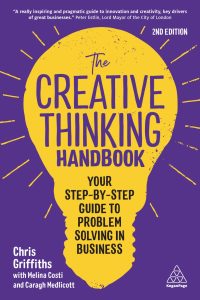By Chris Griffiths, below, author of The Creative Thinking Handbook, and founder of the mind mapping app www.ayoa.com
 People often say if you always do what you’ve always done, you will always get what you always got. Not any more! The main reason that innovation efforts fail is that they are often killed by leaders who are pessimistic and resist the challenges being made to the status quo.
People often say if you always do what you’ve always done, you will always get what you always got. Not any more! The main reason that innovation efforts fail is that they are often killed by leaders who are pessimistic and resist the challenges being made to the status quo.
As a leader, you are a change architect, and you will undoubtedly run into opposition and misgivings about new ideas being implemented. This is sometimes known as the status quo bias, which inclines leaders to keep things the way they are, even if they didn’t originally choose their current position. They often avoid the risks generated by change, even when the risks are far less than if they were to make no change!
Optimism is massively underrated in business, and yet study after study has found it to be an indispensable quality in leaders that others want to follow. It is important in a general sense, but it is even more vital when attempting to drive real innovative growth. Making any type of change requires marshalling a great deal of energy, and optimism is the fuel that powers us along with the hope that we are making things better.
Optimism brings positive action and mental resilience, which are necessary for growth and flourishing. Linked to this is research undertaken by Stanford psychology professor Carol Dweck (2006) on the differences between people with fixed and growth mindsets. Looking at her findings from a leadership perspective, we learn that bosses with a fixed mindset operate from a philosophy that people’s basic qualities (such as personality, intelligence and talents) are carved in stone. They’re of the mind that you make do with what you’re born with and have little belief that they or others can change.
Unsurprisingly, developing people’s creativity and inventiveness is not a priority for these immutable types. However, leaders with a growth mindset assume people’s basic qualities can be developed with work and determination. They place great value on learning, are open to feedback, and are confident in their ability to cultivate their own and others’ creative talents. These leaders seek out constructive ways to praise, empower and motivate their workers and are resilient in the face of setbacks. There’s no way around it. If you want to be a leader who helps people enhance their creative abilities and fulfil their potential, you have to be optimistic about it.
Optimism feeds positive emotions and engagement, which are antecedents of creativity. Barbara Frederickson’s (2004) work on the study of positive emotions led her to develop the Broaden and Build Theory, the substance of which is that positive emotions, such as joy, interest and gratitude, do much more than cause happiness and contentment in the moments we experience them. They also broaden behaviours such as play, awareness, discovery and inquisitiveness. When we experience positive emotions, our minds open up to new possibilities, actions and ideas, and we become more flexible and creative in the way we work. As you apply optimism as a leader and allow people to enjoy what they’re doing, you will find that in time they will be more inclined to experiment and show initiative.
How can you be a more optimistic influence to your team? Here are some quick pointers you can put to the test:
Be positive, no matter what.
First off, practise being positive and upbeat every day. Don’t fall into the trap of only being positive when something good or momentous happens; it’s easier to maintain a positive attitude on an ongoing basis than it is to regain it once you’ve succumbed to negativity.
Embrace newness.
When a new idea is introduced, get behind it fully and make sure you encourage everyone to ‘give it their best shot’. Be positive about changes to new products, processes or procedures. Lukewarm initiatives are unlikely to become roaring successes. Some failure is OK, but if teams see innovations flop time and time again, they won’t be inspired to keep creating.
Master your strengths.
Focus on what you and others do well and build from there. Commit to your professional development. Your journey to mastery will bring confidence and a growing capability to succeed. Be on the lookout for victories and celebrate them along the way. By ritually fuelling the growth of your team, you’ll be hardwiring yourself to be a more optimistic and innovative leader.
Take in inspirational material on a daily basis.
I like to watch TED videos on entrepreneurship and innovation and read about the latest cognitive research. Others might prefer daily quotations, motivational tapes or reading biographies of successful people. What can you read/watch/listen to/play to get a jolt of optimism and good feeling each day? You can even watch me talking about creativity at a TEDx event.
See the silver lining.
We can all learn to reframe our thoughts to look for the hidden positives in any negative situation – the 90 per cent we still have rather than the 10 per cent we have lost. That bit of bad news or bad luck won’t last forever. Shift your attitude to being helpful, not helpless. What can you do right now to alleviate the situation? Is there an opportunity hidden here somewhere? If there’s nothing you can do, don’t dwell on it.
Expect people to succeed.
One of the most powerful gifts you can give someone is to believe in their potential. This is the key to helping them accomplish more and more. Even when a member of your team fails to achieve what they set out to do, don’t wallow with them. Give them encouragement instead so that they feel energised to tackle the next challenge: ‘Never mind. I know you’ll do better next time.’
Positive thinking alone rarely leads to good outcomes so remember that whilst it is critical to drive your innovation strategies using optimism, you must also ensure you utilise a system or process to remain balanced in your thinking.

Chris Griffiths is a keynote speaker on innovation and resilience, author of The Creative Thinking Handbook, and founder of the mind mapping app www.ayoa.com


